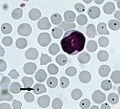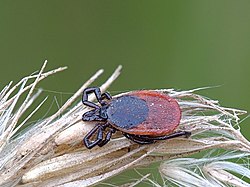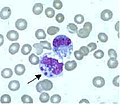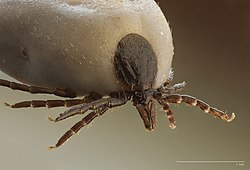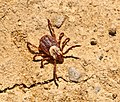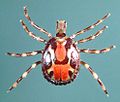Anaplasma is a genus of gram-negative bacteria of the alphaproteobacterial order Rickettsiales, family Anaplasmataceae. Anaplasma species reside in host...
5 KB (384 words) - 09:08, 6 December 2024
Anaplasma phagocytophilum (formerly Ehrlichia phagocytophilum) is a Gram-negative bacterium that is unusual in its tropism to neutrophils. It causes anaplasmosis...
9 KB (956 words) - 13:43, 7 May 2025
Anaplasma bovis is a gram negative, obligate intracellular bacterium, which can be found in wild and domestic ruminants, and potentially a wide variety...
24 KB (2,644 words) - 15:43, 16 March 2025
tick-borne disease affecting ruminants, dogs, and horses, and is caused by Anaplasma bacteria. Anaplasmosis is an infectious but not contagious disease. Anaplasmosis...
18 KB (2,093 words) - 11:44, 29 December 2024
granulocytic anaplasmosis (HGA) is a tick-borne, infectious disease caused by Anaplasma phagocytophilum, an obligate intracellular bacterium that is typically...
21 KB (2,313 words) - 12:06, 24 May 2025
caused by bacteria of the family Anaplasmataceae, genera Ehrlichia and Anaplasma. These obligate intracellular bacteria infect and kill white blood cells...
18 KB (1,924 words) - 15:18, 6 February 2025
Anaplasma platys (formerly Ehrlichia platys) is a Gram-negative bacterium. Dumler JS, Barbet AF, Bekker CP, et al. (2001). "Reorganization of genera in...
1 KB (89 words) - 16:59, 17 April 2023
tick-borne fever (Anaplasma phagocytophila), Q fever (Coxiella burnetii), Boutonneuse fever (Rickettsia conorii), and the bacterium Anaplasma marginale. Horses...
11 KB (1,145 words) - 20:38, 31 May 2025
and Oregon, and Ixodes ricinus in Europe. D. variabilis may also carry Anaplasma phagocytophilum, the causative agent of human granulocytic anaplasmosis...
12 KB (1,446 words) - 13:13, 8 June 2025
chaffeensis and Ehrlichia canis. It is also closely related to Wolbachia, Anaplasma, and Neorickettsia bacteria, with Rickettsia as a more distant genus....
9 KB (1,047 words) - 20:14, 17 April 2025
parasites present in the blood of calves infected with the Oregon strain of Anaplasma marginale". Am J Vet Res. 24: 697–702. PMID 14035670. Euzéby JP, Parte...
4 KB (259 words) - 15:54, 11 May 2023
Actinomyces israelii Agrobacterium radiobacter Agrobacterium tumefaciens Anaplasma Anaplasma phagocytophilum Azorhizobium caulinodans Azotobacter vinelandii viridans...
7 KB (451 words) - 13:13, 23 May 2025
1603/0022-2585-40.6.1000. PMID 14765684. Baneth, G. (2010). Ehrlichia and anaplasma infections. Paper presented at World small animal veterinary congress...
6 KB (682 words) - 03:23, 2 December 2024
carry and transmit several other parasites, such as Babesia microti and Anaplasma phagocytophilum, which cause the diseases babesiosis and human granulocytic...
17 KB (1,719 words) - 18:59, 10 May 2025
Candidatus Anaplasma sparouinense is an emerging intracellular bacterial pathogen. Anaplasma sparouinense was first detected in a 58-year-old man living...
3 KB (263 words) - 04:56, 30 December 2024
spirochetes, spotted fever group rickettsiae, Ehrlichia chaffeensis, and Anaplasma bovis have been detected in H. longicornis. It has been associated with...
10 KB (990 words) - 11:58, 24 September 2024
Transstadial transmission (section Anaplasma spp.)
Anaplasma in ticks. Ruminants are the primary reservoir for Anaplasma spp., but the bacteria can also be found in wild animals. In ticks, Anaplasma spp...
20 KB (2,090 words) - 05:46, 23 May 2025
Garcia-Garcia JC, et al. (December 2005). "Human granulocytic anaplasmosis and Anaplasma phagocytophilum". Emerging Infectious Diseases. 11 (12): 1828–34. doi:10...
8 KB (768 words) - 20:22, 27 May 2025
Babesia, which cause babesiosis, and bacteria from the related genus Anaplasma, which cause anaplasmosis. These species are recognised within the genus...
31 KB (2,410 words) - 18:32, 20 February 2025
Rocky Mountain spotted fever, Coxiella burnetii, which causes Q fever, Anaplasma marginale, which causes anaplasmosis in cattle, Francisella tularensis...
9 KB (815 words) - 21:16, 21 May 2025
ewingii ehrlichiosis has a decreased incidence of complications. Like Anaplasma phagocytophilum, the causative agent of human granulocytic ehrlichiosis...
4 KB (382 words) - 19:04, 4 February 2024
the order Rickettsiales: unification of some species of Ehrlichia with Anaplasma, Cowdria with Ehrlichia and Ehrlichia with Neorickettsia, descriptions...
1 KB (92 words) - 23:08, 20 April 2025
distribution of Dirofilaria immitis, Borrelia burgdorferi, Ehrlichia canis, and Anaplasma phagocytophilum in dogs in the United States: Results of a national clinic-based...
9 KB (1,046 words) - 03:22, 2 December 2024
appendage. T4SS has two effector proteins: firstly, ATS-1, which stands for Anaplasma translocated substrate 1, and secondly AnkA, which stands for ankyrin...
26 KB (2,981 words) - 17:13, 22 May 2025
and goats suffer disease from infection with Anaplasma ovis which is transmitted similarly to the anaplasmas described above. Ehrlichia ruminantium (formerly...
63 KB (7,888 words) - 16:23, 2 June 2025
Mycobacterium such as Mycobacterium leprae, that survive in phagocytes Anaplasma phagocytophilum Protozoan examples (that affect humans) include: Apicomplexans...
16 KB (1,722 words) - 08:17, 25 May 2025
Rickettsiaceae/ (Rickettsioses) Anaplasmataceae Ehrlichiosis: Anaplasma phagocytophilum Human granulocytic anaplasmosis, Anaplasmosis Ehrlichia chaffeensis...
129 KB (13,094 words) - 02:48, 27 May 2025
Rickettsiaceae/ (Rickettsioses) Anaplasmataceae Ehrlichiosis: Anaplasma phagocytophilum Human granulocytic anaplasmosis, Anaplasmosis Ehrlichia chaffeensis...
57 KB (5,710 words) - 07:18, 21 May 2025
inconvenience and unpleasantness of removing keds from hair and clothes. Anaplasma phagocytophilum, a Gram-negative, obligately intracellular bacterium that...
13 KB (1,241 words) - 10:15, 15 January 2025
may sometimes affect phenotype. Ehrlichia and its closely related genus Anaplasma show extreme diversity in the structure and content of their genomes....
17 KB (1,940 words) - 13:01, 9 May 2025



